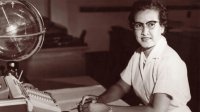Look Beyond the Struggle to Celebrate Black Achievement
In addition to recognizing the civil rights movement, teachers can use Black History Month to call attention to the achievements of Black Americans in other areas.
Your content has been saved!
Go to My Saved Content.If you were to set up a Black history “Man on the Street” interview to ask what names people connected with Black History Month, you’d undoubtedly repeatedly hear Martin Luther King Jr., Rosa Parks, and Harriet Tubman because of their significance in the struggle for civil rights and abolition. You might even hear about music and sports icons like Billie Holiday and Michael Jordan.
Names you’d hear less often would be those of the hosts of famous millionaires, inventors, scientists, writers, and other Black American influencers from diverse industries and sectors. If you recognize the value in celebrating not just Black struggle but Black achievement, here are some resources you can share with your students.
For STEM Lovers
By now, Katherine Johnson, whose story was portrayed in the movie Hidden Figures, may be known to you. She was one of the mathematical engineers who helped NASA put astronauts on the moon. NASA’s K–12 Modern Figures Toolkit can arm you with lessons and activities about Johnson and the mathematicians she worked with to highlight lesser-known STEM greats.
Johnson died in February 2020, and her story illustrates not only achievement but also how close we are to the time when segregation was still the order of the day. NASA features additional activities and fact sheets about Black astronauts and engineers on their website, and you can also use the search function on their STEM Engagement page.
For Makers and Inventors
If your students are makers and tinkerers, there’s no shortage of Black inventors for them to learn about. In addition to the popular botanist and inventor George Washington Carver, there’s Frederick Jones, who made mobile refrigeration possible, allowing for the safe transport of food and medical supplies.
You can also highlight the inventions of Granville T. Woods, the man responsible for making train travel safe through his communication system. Not only did he register more than 60 patents, but also he had to defend those patents against giants like Thomas Edison, who took him to court twice unsuccessfully to lay claim to Woods’s work.
For Budding Entrepreneurs
For Wall Street watchers, the owner of the Atlanta Life Insurance Company might catch their interest. Alonzo Herndon was penniless when he was emancipated from enslavement, but he went on to build an empire that included several thriving businesses. There are also helpful activities and resources about his life on the Georgia Public Broadcasting site.
Further, your students may have heard of the Tulsa Massacre, but they probably haven’t heard much about Ottawa W. Gurley, the man who planned out the Greenwood community in Oklahoma known as “Black Wall Street.” Gurley, born to a freed enslaved couple, worked as a teacher, postal worker, and principal but excelled at entrepreneurship.
He owned land and was responsible for mapping out the community of Greenwood. Gurley was able to build hotels and churches and to lend money to other fledgling businesses. His worth at the time of the Tulsa Massacre was said to be $200,000, or about $4 million in purchasing power today.
For Creatives
Musicians like James Reese Europe and his Clef Club Orchestra, the first all-Black orchestra to play Carnegie Hall, might interest your budding musicians. Or maybe they would like to know about Lorraine Hansberry, who, while only 34 when she died, is still considered one of the greatest African American playwrights because of her renowned work A Raisin in the Sun, the first play on Broadway written by a Black female playwright.
Perhaps your students would like to know about female millionaire Madame C. J. Walker, who created hair products for textured hair long before Carol’s Daughter and Miss Jessie. For students who are interested in masters of the canvas, introduce Robert S. Duncanson, said to be the most brilliant landscape painter of the West.
Finally, for those who dream of influencer fame, you could introduce socialites like Blanche Dunn, described as Harlem’s “It girl,” or Jeremiah Hamilton, a businessman who managed to defy the boundaries of racism to be named New York’s first Black millionaire.
While the story of the enslavement of Black people in this country began in 1619 when the first ship trafficking humans arrived at Point Comfort, Virginia, there’s much more to the story than Harriet Tubman. Even the years of Jim Crow, from the Reconstruction era until the late 1960s, when Rosa Parks and John Lewis fought segregation with Dr. King and many other prominent civil rights leaders, don’t tell the whole story.
The story of the Black community lies in the breadth and diversity of the Black experience and an indomitable spirit that has met challenge after challenge to succeed and celebrate on American soil since before the United States became an independent nation.
The greatness of civil rights icons like Martin Luther King Jr., Rosa Parks, and Harriet Tubman isn’t diminished when we add celebration to the remembrance of struggle. Quite the contrary—by sharing stories of pride and achievement, we honor their memory by highlighting the achievements that their sacrifices allowed to happen.
